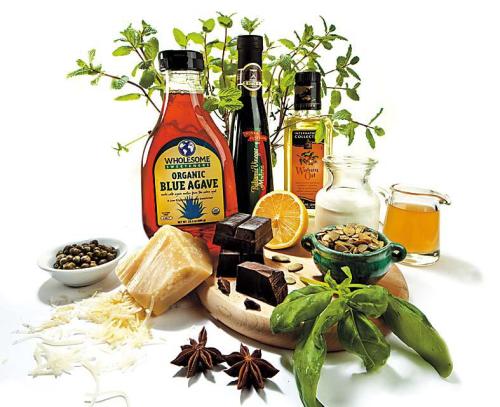Amp up dull dishes with easy tricks that add flavor, balance
By Korea HeraldPublished : Jan. 27, 2012 - 19:30
You can follow a recipe to the letter, but you don’t really begin to cook until you learn to play with your food. To be precise, learn to play with a few key ingredients and cooking techniques to boost the flavor of a dish, moving it from boring to beautiful.
Consider a simmering pot of split pea soup we made the other day. Followed the recipe to the letter. Didn’t need salt. Didn’t need pepper. But it was downright dull. Try apple cider vinegar, suggested a friend. We stirred in a good splash. Beautiful. With almost zero effort and cost, we amped up the flavor.
Consider a simmering pot of split pea soup we made the other day. Followed the recipe to the letter. Didn’t need salt. Didn’t need pepper. But it was downright dull. Try apple cider vinegar, suggested a friend. We stirred in a good splash. Beautiful. With almost zero effort and cost, we amped up the flavor.

Dull food can be saved. Just ask chef Lauren Braun Costello.
“Brighten with acid or salt. Enrich with fat. Restaurants use animal fat and salt to enhance flavor. Vinegar, lemon juice, finishing oils, butter and sugar are all old standbys,” she writes in “Notes on Cooking: A Short Guide to an Essential Craft” (RCR Creative Press, $21.95), a tiny book written with Russell Reich and packed with kitchen wisdom.
For more insight, we tracked down Braun Costello at her home in New York.
Think flavors (and where to find them): Sweet (honey, sugar, agave, corn). Salty (Parmesan, capers, salt). Sour (vinegar, lemons, limes). Bitter (chocolate, coffee, Swiss chard).
Think balance: “Sometimes people throw hot sauce on something. That’s flavoring it, that’s making it spicy. But if you’re talking about a melody, that’s just one note. ... Counterbalance that with a little sweetness with honey or sugar,” she says.
“Balancing flavors is like writing a glorious song. It makes the dish, and the mind of the diner, dance.”
Think heat: “When you apply heat to something ― whether to sear it or fry it or grill it or roast it ― before you add it into something, that’s what creates the depth of flavor,” Braun Costello adds.
Ready to play with your food? Well, put all your senses (taste, touch, sense, smell) on alert. Then, as Braun Costello puts it, “mess with the recipe.”
Armed with a few of her ideas below, head into the kitchen with this quote she offers from writer Ray Bradbury: “Life is trying things to see if they work.”
Acid: Vinegars and lemon. “You cannot go wrong most of the time with adding acid to a dish,” she says. “It adds brightness.”
Toast: Toast spices before using them to bring out their aromatic oils. “In Indian cuisine, they toast the cumin or coriander seeds in a pan that’s dry or with a little oil, and that releases the flavors.”
Texture: Chop coarsely? Chop finely? Puree? “One always has the choice when making a dish to sort of punctuate rusticity or work toward a velvety texture.”
Sweet: “Sweetness is not to be forgotten in the savory canon.” A touch of sugar, agave syrup or balsamic vinegar can boost a dull tomato sauce.
Specialty salt: “Maldon salt is particularly fun because it has a textural component. It’s kind of flaky and chunky in a way, and it gives that textural element too,” she says. “There are many different finishing salts that people can play with too, like smoked alderwood salt.”
Salt: “Salt makes everything brighter and stronger,” she says “That doesn’t mean that things should taste salty. It’s just that little pinch that completely transforms it.” Parmesan, capers and other foods are good ways to add salt.
Flavored oils: Think of seasoned oils ― such as lemon oil, toasted nut oils or an herb oil ― as finishing oils. “Just a little touch not only adds great visual contrast, but it can brighten the flavor of a soup or a piece of protein,” she says.
By Judy Hevrdejs
(Chicago Tribune)
(Distributed by MCT Information Services)
-
Articles by Korea Herald


![[Exclusive] Korean military set to ban iPhones over 'security' concerns](http://res.heraldm.com/phpwas/restmb_idxmake.php?idx=644&simg=/content/image/2024/04/23/20240423050599_0.jpg&u=20240423183955)

![[Graphic News] 77% of young Koreans still financially dependent](http://res.heraldm.com/phpwas/restmb_idxmake.php?idx=644&simg=/content/image/2024/04/22/20240422050762_0.gif&u=)



![[Pressure points] Leggings in public: Fashion statement or social faux pas?](http://res.heraldm.com/phpwas/restmb_idxmake.php?idx=644&simg=/content/image/2024/04/23/20240423050669_0.jpg&u=)










